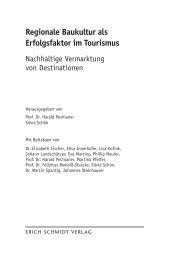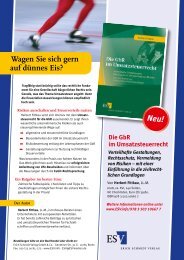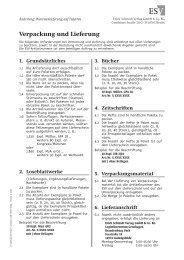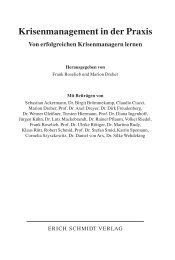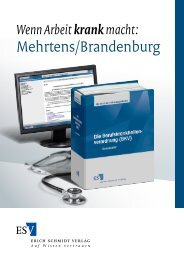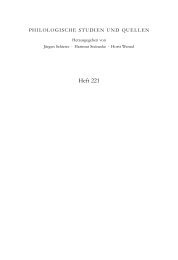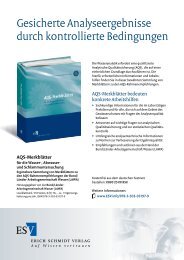The Role of Internal Audit in Corporate Governance in Europe
The Role of Internal Audit in Corporate Governance in Europe
The Role of Internal Audit in Corporate Governance in Europe
You also want an ePaper? Increase the reach of your titles
YUMPU automatically turns print PDFs into web optimized ePapers that Google loves.
<strong>Europe</strong>an Confederation<br />
<strong>of</strong> Institutes <strong>of</strong> <strong>Internal</strong> <strong>Audit</strong><strong>in</strong>g (ECIIA) (Ed.)<br />
<strong>The</strong> <strong>Role</strong> <strong>of</strong> <strong>Internal</strong> <strong>Audit</strong><br />
<strong>in</strong> <strong>Corporate</strong> <strong>Governance</strong><br />
<strong>in</strong> <strong>Europe</strong><br />
Current Status, Necessary Improvements, Future Tasks<br />
Edition under the special guidance<br />
<strong>of</strong> Bernd Schartmann<br />
ERICH SCHMIDT VERLAG
Bibliographic <strong>in</strong>formation published by Die Deutsche Bibliothek<br />
Die Deutsche Bibliothek lists this publication <strong>in</strong> the<br />
Deutsche Nationalbibliografie; detailed bibliographic data<br />
are available <strong>in</strong> the Internet at http://dnb.ddb.de.<br />
For further <strong>in</strong>formation concern<strong>in</strong>g this title please follow this l<strong>in</strong>k:<br />
ESV.<strong>in</strong>fo/978 3 503 10056 9<br />
With the support <strong>of</strong> the<br />
Deutsches Institut für Interne Revision e.V.<br />
(IIA Germany)<br />
ISBN: 978 3 503 10056 9<br />
All rights reserved<br />
© Erich Schmidt Verlag GmbH & Co., Berl<strong>in</strong> 2007<br />
www.ESV.<strong>in</strong>fo<br />
This paper fulfills the requirements <strong>of</strong> the<br />
Frankfurter Forderungen <strong>of</strong> Die Deutsche Bibliothek<br />
and the Gesellschaft für das Buch concern<strong>in</strong>g the paper permanence<br />
and meets the tight regulations <strong>of</strong> American National Standard<br />
Ansi/Niso Z 39.48-1992 as well as ISO 9706<br />
Typesett<strong>in</strong>g: multitext, Berl<strong>in</strong><br />
Pr<strong>in</strong>t<strong>in</strong>g and B<strong>in</strong>d<strong>in</strong>g: Strauss, Mörlenbach
Content<br />
1 Introduction ................................................................................................. 7<br />
2 Results <strong>of</strong> the Survey .................................................................................. 9<br />
2.1 General questions regard<strong>in</strong>g <strong>Corporate</strong> <strong>Governance</strong> <strong>in</strong> <strong>Europe</strong> ..... 9<br />
2.1.1 Do you have a specific def<strong>in</strong>ition <strong>of</strong> <strong>Corporate</strong><br />
<strong>Governance</strong> with<strong>in</strong> your country? ........................................... 9<br />
2.1.2 Which legal requirements regard<strong>in</strong>g <strong>Corporate</strong><br />
<strong>Governance</strong> exist <strong>in</strong> your country? .......................................... 10<br />
2.1.3 Which EU wide regulations regard<strong>in</strong>g <strong>Corporate</strong><br />
<strong>Governance</strong> need to be fulfilled? ............................................. 14<br />
2.1.4 How and by whom is/was the Implementation process <strong>of</strong><br />
<strong>Corporate</strong> <strong>Governance</strong> organised <strong>in</strong> your country? ............... 16<br />
2.1.5 Please list all companies which accepted the <strong>Corporate</strong><br />
<strong>Governance</strong> Code ..................................................................... 17<br />
2.1.6 Are there any customer/stakeholder requirements for<br />
<strong>Corporate</strong> <strong>Governance</strong> <strong>in</strong> your country? ................................. 17<br />
2.1.7 How would you estimate the awareness <strong>of</strong> <strong>Corporate</strong><br />
<strong>Governance</strong> <strong>in</strong> your country? ................................................... 18<br />
2.1.8 How would you estimate the acceptance <strong>of</strong> <strong>Corporate</strong><br />
<strong>Governance</strong> <strong>in</strong> your country? ................................................... 19<br />
2.2 Specific questions regard<strong>in</strong>g the current <strong>in</strong>volvement <strong>of</strong> <strong>Internal</strong><br />
<strong>Audit</strong> <strong>in</strong> <strong>Corporate</strong> <strong>Governance</strong> aspects ............................................ 20<br />
2.2.1 What role did the <strong>in</strong>stitute play <strong>in</strong> the CG-development<br />
process? ...................................................................................... 20<br />
2.2.2 What role did your <strong>in</strong>stitute play <strong>in</strong> the CG-implementation<br />
process? ........................................................................... 21<br />
2.2.3 Is the role <strong>of</strong> <strong>Internal</strong> <strong>Audit</strong> def<strong>in</strong>ed <strong>in</strong><br />
the CG-Code/Law? .................................................................... 21<br />
2.2.4 Are there any requirements towards your organisation<br />
members regard<strong>in</strong>g CG? .......................................................... 21<br />
2.2.5 In case there are any specific regulations: are they<br />
subject to year end audit? ........................................................ 22<br />
2.2.6 In case there are any specific regulations: are they<br />
subject to <strong>in</strong>ternal audit? .......................................................... 22<br />
2.2.7 What is your personal op<strong>in</strong>ion regard<strong>in</strong>g CG? ...................... 22<br />
5
Content<br />
3 State <strong>of</strong> the art <strong>Internal</strong> <strong>Audit</strong> ................................................................... 23<br />
3.1 Position <strong>of</strong> <strong>Internal</strong> <strong>Audit</strong> <strong>in</strong> a <strong>Corporate</strong> Organisation .................. 23<br />
3.1.1 Organisation <strong>of</strong> <strong>Internal</strong> <strong>Audit</strong> Function ................................ 24<br />
3.1.2 Relationship <strong>of</strong> <strong>Internal</strong> <strong>Audit</strong> with other Stakeholders<br />
<strong>of</strong> CG .......................................................................................... 25<br />
3.1.3 Skill set and Tra<strong>in</strong><strong>in</strong>g................................................................ 26<br />
3.2 Scope <strong>of</strong> <strong>Internal</strong> <strong>Audit</strong> ....................................................................... 27<br />
3.2.1 <strong>Internal</strong> Environment (Control Environment) ....................... 29<br />
3.2.2 Risk Management ..................................................................... 29<br />
3.2.3 <strong>Internal</strong> Control System ........................................................... 33<br />
3.2.4 Information & Communication .............................................. 36<br />
3.3 Quality Management <strong>in</strong> <strong>Internal</strong> <strong>Audit</strong> ............................................. 36<br />
4 Proposals for the <strong>Role</strong> <strong>of</strong> <strong>Internal</strong> <strong>Audit</strong> <strong>in</strong> <strong>Corporate</strong> <strong>Governance</strong><br />
<strong>in</strong> <strong>Europe</strong> .................................................................................................... 39<br />
4.1 Support<strong>in</strong>g an Effective Enterprise Risk Management .................... 39<br />
4.2 Support to ensure compliance ........................................................... 39<br />
4.4 Enhanced set up <strong>of</strong> <strong>Internal</strong> <strong>Audit</strong> Function ................................... 40<br />
4.3 Tak<strong>in</strong>g a more active role <strong>in</strong> support<strong>in</strong>g companies code<br />
<strong>of</strong> ethics ............................................................................................... 40<br />
4.5 Form<strong>in</strong>g a support<strong>in</strong>g role <strong>in</strong> Executive Board tasks ..................... 41<br />
4.6 Increased cooperation with External <strong>Audit</strong>ors .................................. 42<br />
4.7 Stronger support for the Board <strong>of</strong> Directors ................................... 43<br />
4.8 Closer Cooperation with Controll<strong>in</strong>g Departments ......................... 44<br />
5 Conclusion and further steps .................................................................... 45<br />
Project team ...................................................................................................... 47<br />
Bibliography ...................................................................................................... 49<br />
Attachments ...................................................................................................... 53<br />
Questionnaire .............................................................................................. 54<br />
Results by country ....................................................................................... 56<br />
6









